Where to Stay in Madrid: Complete Guide for First Timers
We’re putting our cards on the table here right at the beginning of this guide: We LOVE Madrid.
It’s our favorite of the major Spanish cities – and we’re here use our experiences exploring Madrid to break the city down into neighborhoods and help you figure out the best place to stay for your particular travel style and budget.
Our first trip to Madrid brought us to the Spanish capital on the heels of a week in Barcelona, and I’m not quite sure what we were expecting, but Madrid blew those expectations out of the water.
A few years later, I (Matt here, the main voice in this corner of the internet) made a return trip to Madrid last spring to dive deeper into Madrid’s culture, history, and (gluten free) food scene, which cemented its place as one of my favorite cities in Europe.
There’s something special about Madrid that other big European cities lack, and I think it has to do with the fact that many tourists overlook Madrid in favor of other parts of Spain, skipping it between Sevilla and Barcelona or spending just a day in Madrid to break up the train journey.
That fact means that you’re seeing and interacting with a higher proportion of local Madrileños when you’re here, resulting in a very distinct culture and cohesive approach to life that you can really feel as you’re exploring the city.
Don’t let those other tourists who skip it fool you, though, Madrid is in our top tier of European cities because it has a great art and culture scene.
The Prado Museum is excellent, and it’s worth doing this early access tour that I recently did to have the normally busy place to yourself), it has an underrated food scene (all of the tapas and Spanish wine, please!), a fascinating history (Madrid was a crumbling castle on a hill until relatively recently), and a laid back, easy going vibe (for lack of a better description).
Hopefully this intro has conveyed our love for Madrid, and we hope you find it as charming and pleasant as we have.
In this guide, we’re going to use our experiences exploring the city to do our best to walk you through all the information you need to figure out the where to stay in Madrid for your particular style, budget, and preferences.
Each neighborhood offers a different blend of vibes, prices, and pros and cons, and we’ll cover it all below so that you’re armed with all the information you need to figure out where to stay for your particular style and budget.
Our intention is that, by the end of this guide, you have everything you need to choose the right place to stay for you and your travel companions.
Sound good to you? Let’s get into it.
Planning a trip to Spain? We have a detailed Spain itinerary plus guides to Barcelona, Granada, and Seville to help you plan an amazing trip!
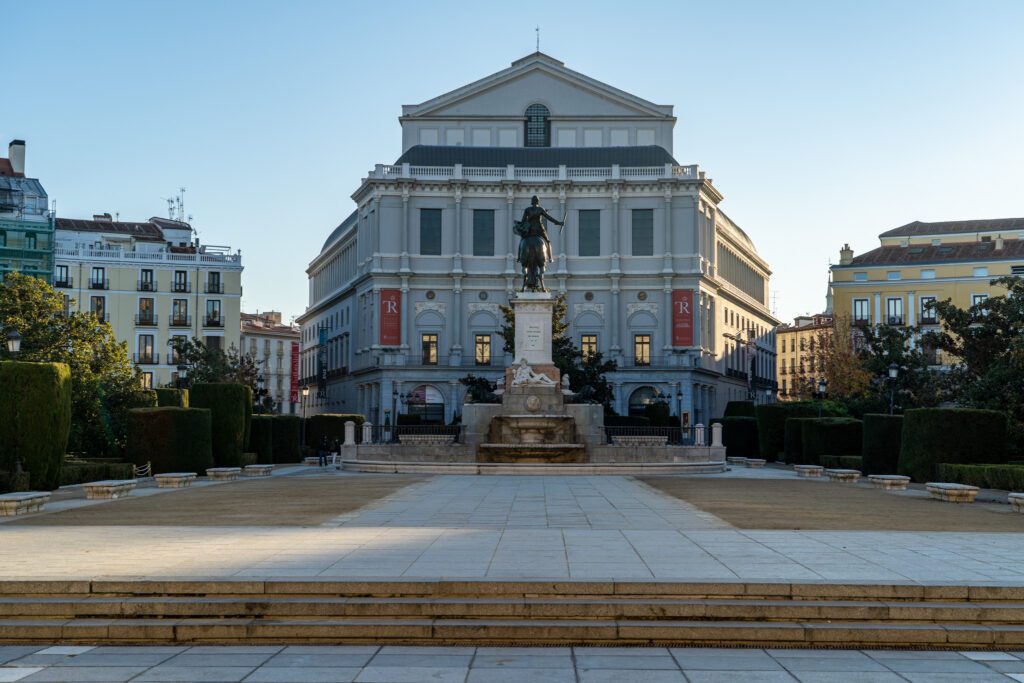
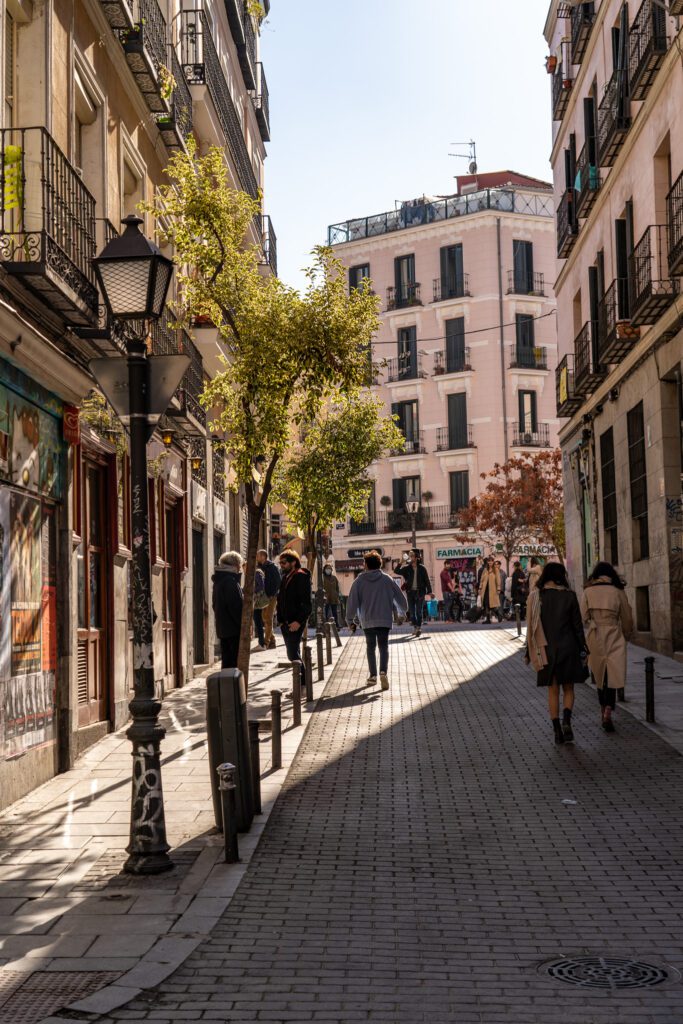
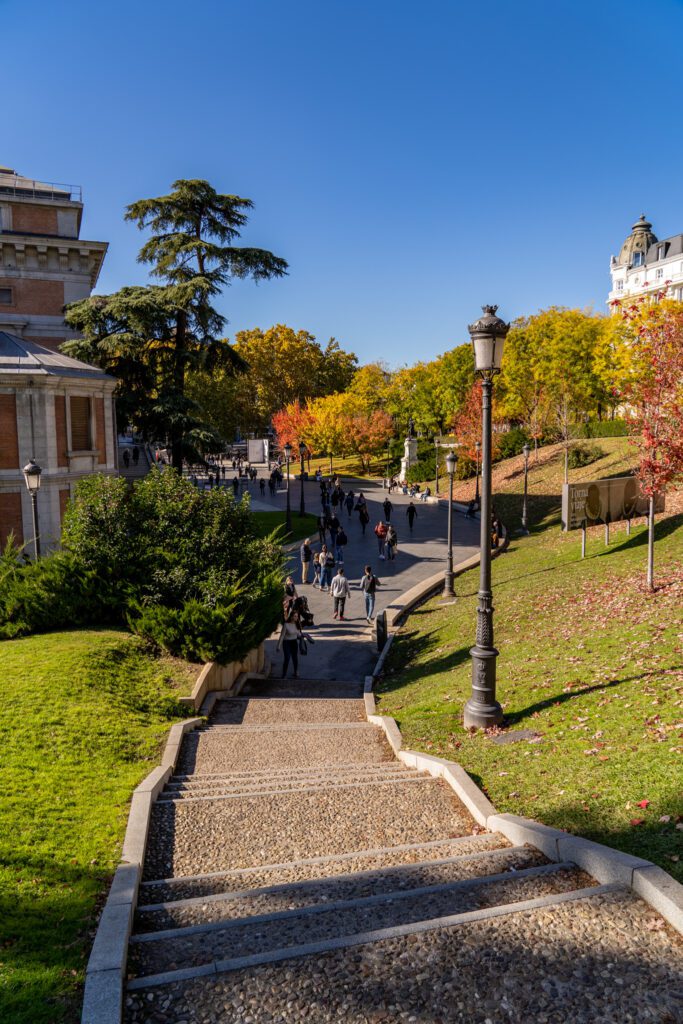
Disclaimer: Some of the links in this post, like hotel links, are affiliate links, meaning at no additional cost to you, we make a little bit of money if you click through and book. That being said, we would never recommend something to you that we don’t stand behind 100%.
Where to Stay in Madrid: The 4 Best Neighborhoods
And now, on to the main event!
Our philosophy when it comes to deciding on a place to stay is to first choose the neighborhood, then move on to finding a great hotel, hostel, or apartment in that area.
The reality is that, depending on what you’re looking for, there are other neighborhoods not included in this guide that might meet your needs.
But these are the four that we think are the best for 99% of travelers, and we’ve shown our work, doing our best to explain why we think that.
Now, we’re well aware that a few of you are currently ready to throw your left shoe at the screen, saying “I don’t have time to read all of that, JUST TELL ME THE BEST PLACE TO STAY!”
Well, here’s a quick summary of this guide if you’re short on time (though we’d recommend reading the section of the place you end up staying for tips and places to add to your list!).
Our overall recommendation for first timers in Madrid is Malasaña, which is our favorite part of the city.
It’s a great central location – I walked everywhere when I stayed here – and it has tons of great places to eat, drink, and shop.
Plus, it’s full of narrow streets and bustling plazas, which are peak Madrid to us. It’s the hippest part of the city, and it’s a mix of tourists and Madrileños that you’ll find out and about until the early hours of the morning (it’s not the quietest part of the city).
If you want a hotel, look at the beautiful 7 Islas Hotel.
If you want an apartment, I stayed at Sonder Malasaña and loved it (and it was quiet!).
If you’re looking for a slightly more affordable and equally convenient area, look at Barrio de las Letras.
It’s on the southeastern side of the city, close to both Parque El Retiro and the train station (Atocha), and it’s historically the part of the city where literary figures like Hemingway and Cervantes spent their lives.
It toes the line between being central but still retaining a lot of the character that makes Madrid special, with plenty of places to eat, drink, and be merry within its borders.
If you want a hotel, stay at Room Mate Alba, a nice boutique hotel right in the middle of all the action.
If you’d prefer an apartment, look at limehome Madrid La Bolsa (we’ve stayed at limehome properties before, and this location gets really good reviews).
If you’re looking for a slice of local life in Madrid, stay in either Salamanca or La Latina.
These two neighborhoods are on opposite sides of the city center, both geographically and culturally.
Salamanca is the northeastern corner of the center, north of El Retiro and the Prado, and is one of the most upscale neighborhoods in the city. It’s green, leafy, charming, and pleasant.
La Latina is in the southwestern corner of the center, and it has retained a lot of the character – like old tapas bars on Calle Cava Baja that have been there for 100 years – that has been lost in other parts of the city.
One important note: It can be loud basically anywhere. Staying out late – like 5am late – is an honored tradition in Spain, and Madrid is no different. While it is certainly correlated with certain areas (namely Malasaña and Chueca), that’s not to say that staying elsewhere means you’re going to be able to sleep peacefully because if you’re near a popular bar or plaza, the party don’t stop til 6 in the morning. The only way to know, really, is to read reviews of places you’re considering, try to book an interior room, and ask for the quietest room possible.
Where We’ve Stayed in Madrid
As usual, we like to start these guides with our own experiences, and in this case, that means covering the places we’ve stayed in Madrid that we’d recommend.
We’ve been to Madrid a couple of times now over the past few years, each time spending a good chunk of time (7 days each) in the city exploring.
On our first trip to Madrid, we spent a full week in the city, and we stayed right on Gran Vía, and I just wouldn’t stay in the area again (so we can swiftly move on to a place I do recommend).
On my – Matt here! – return trip to Madrid, I was traveling solo and spent a week staying in Malasaña, which I was very excited about because it was my favorite part of the city to explore on that first visit.
One of the things that is a major downside of Malasaña is the fact that it can be LOUD.
Especially if you happen to be near a busy plaza, like Plaza Dos de Mayo. And Spaniards aren’t exactly known for early bedtimes (or for being early risers, which I very much am).
Lucky for me (luck is only part of it – I read lots of reviews!), I stayed at Sonder Malasaña and it was SO QUIET.
Sonder is a company that is sort of like Airbnb, but rather than simply connecting travelers and hosts, they play an active role in hosting and actually own the properties they are renting out (which has both pros and cons).
It’s a pretty high-tech experience, where you have to download an app and there’s sometimes nobody onsite to help with issues (I didn’t have any in Madrid), which means it’s not everyone’s cup of tea.
But my one bedroom apartment was clean, comfortable, had a nice kitchen, and had a nice little terrace to enjoy some fresh air.
I’d definitely recommend Malasaña – I don’t think I ate or had coffee outside of Malasaña for the first few days of my trip – but be sure to read reviews about the noise levels of anywhere you’re considering staying.
If you’re looking for the best introductory walking tour to Madrid, I want you to run – don’t walk – to book Lexi’s historical walking tour for your first day in Madrid.
A little background on why I think I can make that “best” statement – by the end of that return trip in 2024, I had done FOUR different walking tours, and Lexi’s was BY FAR the best in terms of storytelling and scope.
She’s a historian (specifically focused on Spanish history), so it makes sense that she has a great grasp on the history, but she also weaves in recommendations on where to eat, drink, and shop (with a handy map sent to you at the end of the trip.
There’s usually one tour in each city that is a cant-miss, and we think this is the one in Madrid.
Click here to check prices, reviews, and availability for Lexi’s tour.
Malasaña: Our Top Pick for Coolest Area in Madrid
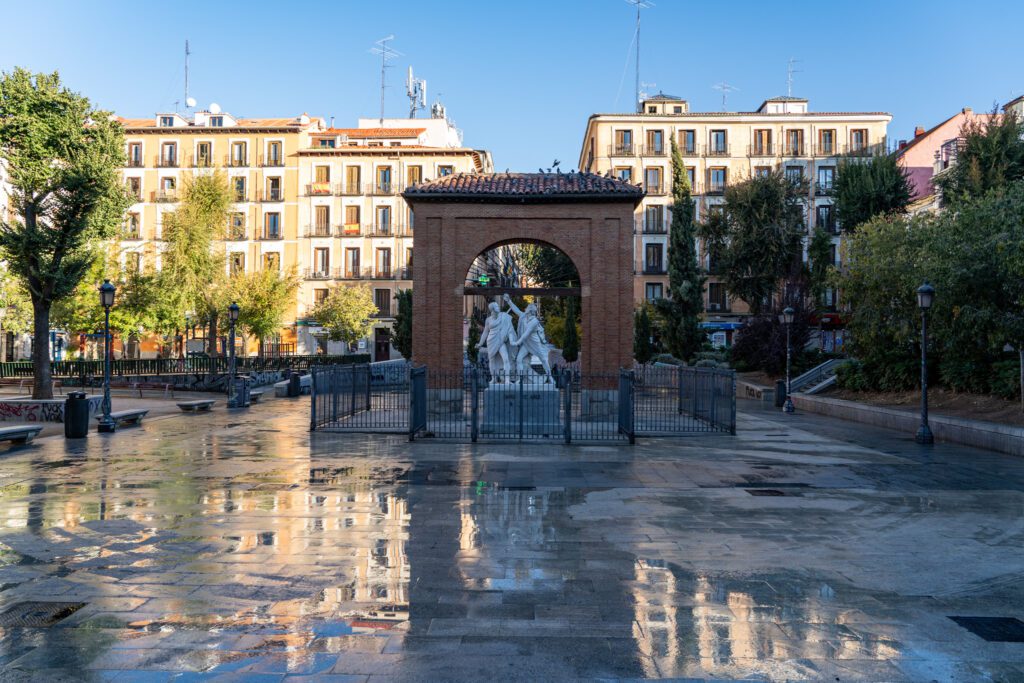
Malasaña – our favorite part of Madrid’s city center – is just north of Gran Vía and stretches up north, getting more residential the further north you go.
Just off of Gran Vía, it’s lively, full of bars and restaurants that are busy starting in the late afternoon and stretching into the early hours of the morning.
We found ourselves in this charming neighborhood many, many times – sometimes multiple times in a day – over the course of our week in Madrid.
The number of coffee shops, bars, restaurants, and shops is unrivaled in any other neighborhood in Madrid, at least in our experience.
Being just off of Gran Vía, it’s also in a central location that will put you within walking distance of most places in Madrid.
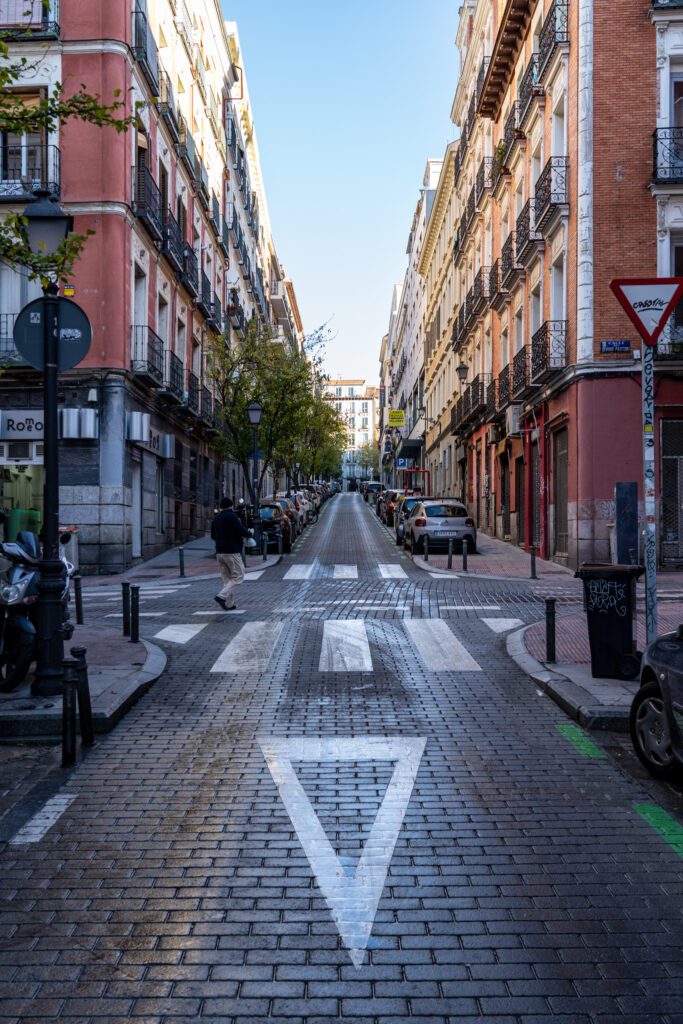
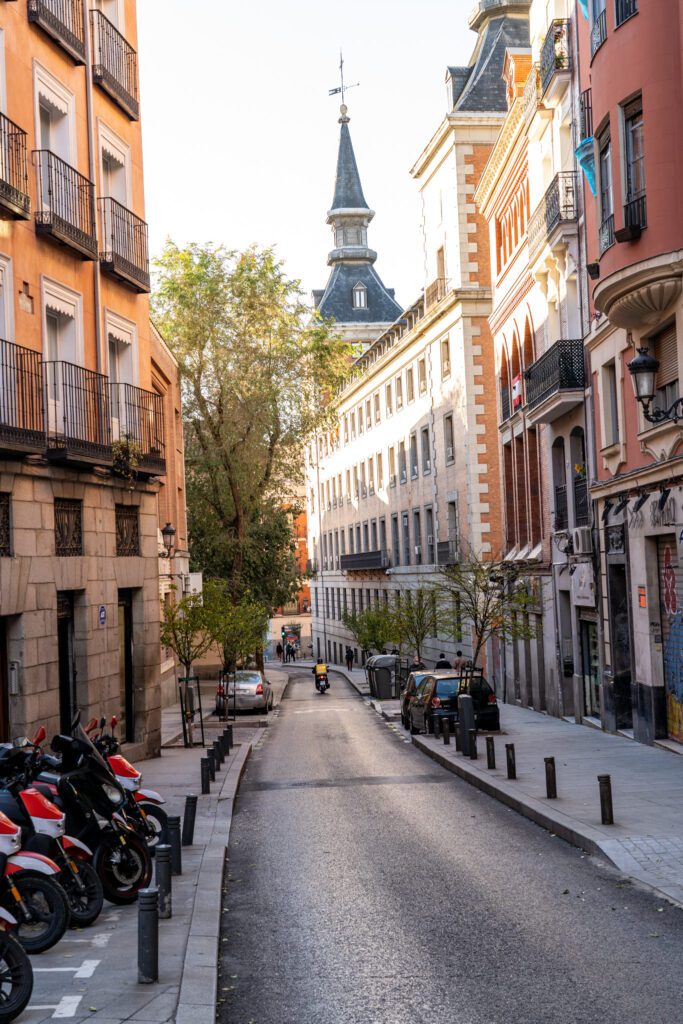
Normally when we talk about hipster, charming neighborhoods in a city – Trastevere or Testaccio in Rome, Capitol Hill or Ballard in Seattle, or Gràcia in Barcelona – the area is not as central as we’d like, but it’s worth the tradeoff to stay in a cooler neighborhood than some of the more central ones.
In Malasaña, you truly get the best of both worlds. You’re central and within walking distance of just about everything you’ll want to see over the course of your Madrid itinerary, and you’re also smack dab in the middle of the coolest neighborhood in central Madrid.
The only tradeoff is that it’s generally a little louder and more boisterous than other areas, with people packing the plazas, bars, and restaurants at all hours.
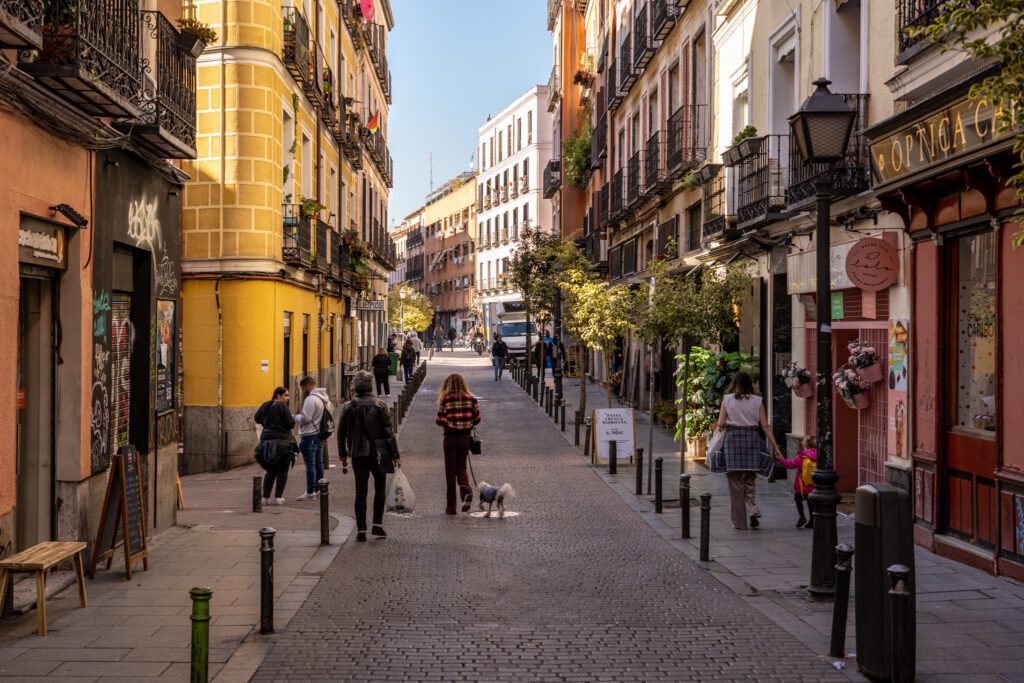
However, you can certainly find quieter corners where you’ll be able to get a full night’s sleep, if that’s what you want.
What about Chueca?
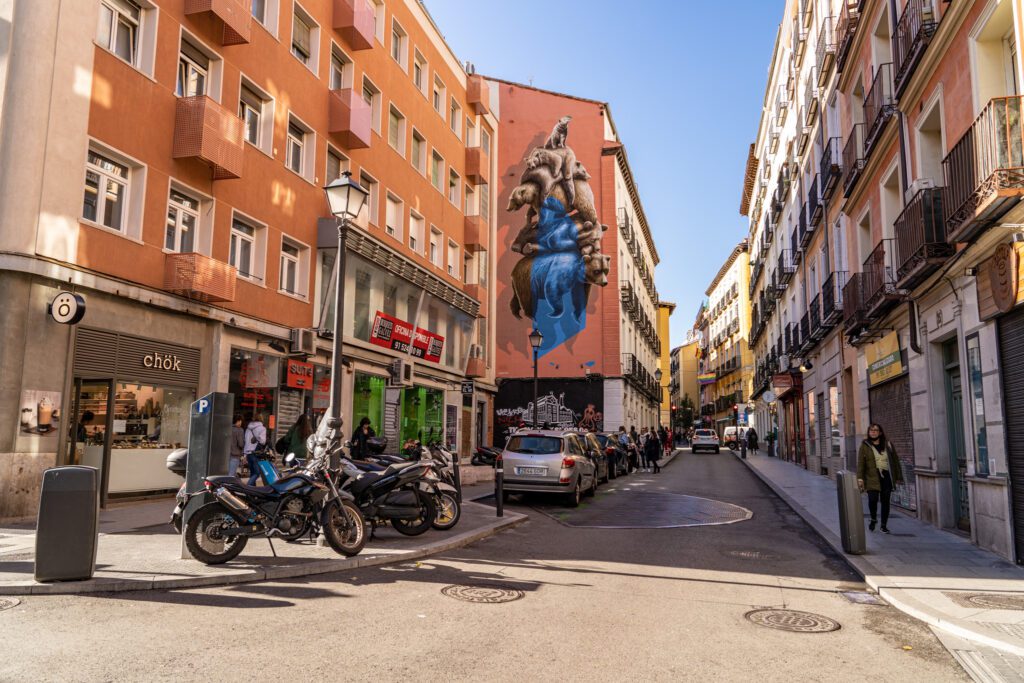
Chueca is the neighborhood immediately to the east, and as I was walking around the two neighborhoods it was really hard to find a real border between them.
They blend together, though as you get closer to where the border is supposed to be, you’ll start to notice more and more rainbow flags – Chueca is one of the more LBGTQ+ focused areas in Madrid, and also a nightlife hub (the two seem to usually go hand-in-hand – see: Capitol Hill in Seattle and the Castro in San Francisco).
For the purposes of this guide, we don’t see enough of a difference between the two to have a completely separate section for them.
Pros and Cons of Staying in Malasaña
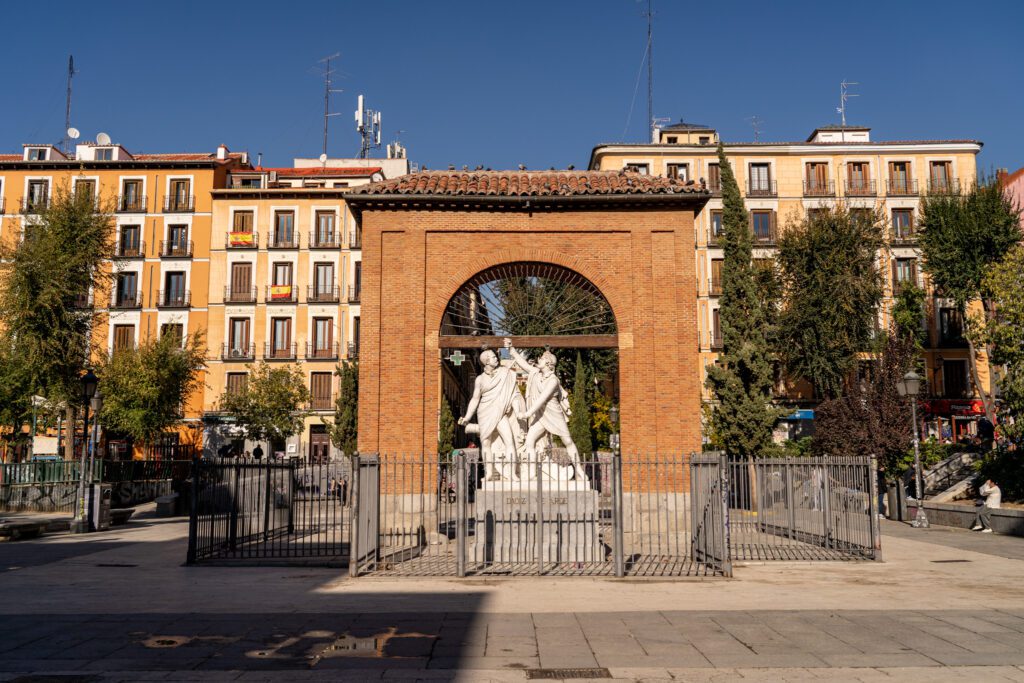
Pros of staying in Malasaña
It’s simultaneously hip and charming. Malasaña is a little bit hipster, and a lot bit charming. Every few blocks, you’ll come across an open plaza with people relaxing in the sun, sipping coffee or a beer, watching the world go by. Open public spaces within cities where people hang out is something that Spain (and Italy, and Colombia, and Mexico…) do really well, and we’re here for more of it at home in the US.
The unparalleled variety of places to eat and drink. In between those charming plazas is an array of shops, bars, and restaurants offering nearly every kind of cuisine or drink under the sun. Authentic Venezuelan, Japanese, Italian – just about every region of the world is represented here.
It’s very central. It’s just north of Gran Vía, the main artery running east-west in Madrid. It’s within walking distance of the Prado, the Royal Palace, and La Latina, which means you’ll be able to walk basically everywhere you want to go.
Cons of staying in Malasaña
It’s loud at night. Parts of the neighborhood are home to some of the best nightlife in Madrid, and as you might imagine, it’s not exactly the quietest place on earth. Walking through the streets after the sun went down, we regularly found most streets in the area packed wall-to-wall with people. If you’re looking for a quieter part, stay further north or further west.
The Best Places to Stay in Malasaña
Here are some places to stay in Malasaña that caught our eye as we were perusing the options.
7 Islas Hotel: Charming & Stylish Hotel
If we hadn’t been in need of a kitchen due to Matt’s Celiac Disease, we might have chosen to stay in this stylish boutique hotel just a few blocks north of Gran Vía in the southern end of Malasaña.
There’s an art gallery on the ground floor, which is probably a little too on-the-nose, but we’re okay with it because of the elegant, minimalist decor in the surprisingly spacious rooms.
A family-owned property, the hotel was completely remodeled in 2012 by the original owner’s granddaughters and it was transformed into the place it is today.
Despite the corporatization of most hotels in major cities around the world over the past decade or two, this hotel is still run by those same three granddaughters, which we think is something worth mentioning and celebrating.
Rooms are simple, stylish, and comfortable, with an industrial-chic sort of theme with touches like those fancy light bulbs that stand alone without a shade.
They also have a penthouse suite with a terrace, which has a lot more room to spread out (nearly double the space, in fact), plus a private terrace with a hammock to relax in the Spanish sun.
Onsite, there’s a bar/cafe that serves specialty coffee and cocktails (along with a beer brewed specially for this hotel) throughout the day, but you’ll definitely want to branch out outside of the hotel to get into the surrounding neighborhood, which is chock full of amazing bars and restaurants.
IBIS Madrid Centro: A Nice Affordable Hotel
This budget-friendly hotel is up on the northern edge of the neighborhood, which does mean that it’s a bit further from most of the places you’re going to be visiting on your Madrid itinerary.
It is just a couple of blocks away from Plaza del Dos de Mayo, though.
However, the price reflects that less central location, which is why it’s here on this list. There are a couple of metro stations within walking distance, depending on which line you need to catch.
IBIS Hotels are nothing particularly special, but they are consistent, which is a nice characteristic to have in a hotel. Rooms are basic but comfortable, with options for double beds and twin beds, depending on who you’re traveling with.
limehome Madrid Calle de la Madera: Stylish Serviced Apartments
After staying in a limehome property in Granada that we absolutely loved, we wish we had stayed at these stylish apartments in Madrid instead of the place we ended up staying.
For context, Matt has Celiac Disease, which makes dining out sometimes difficult and means we try to always have access to a kitchen so that we have the option to cook for ourselves.
This property is basically an apart-hotel. Rather than being a single apartment being rented out by an individual or investment group, it’s more like a hotel, but the rooms are apartments with amenities like living areas and kitchens.
That generally means you’ll have more space to spread out, which we appreciate given we’re often doing work and writing when we’re traveling, which is not particularly pleasant in a cramped hotel room with only a bed to sit on.
There are a variety of apartments here, from studios (choose between small, medium, and large depending on your needs and preferences) and one-bedroom options, again with various sizes and configurations.
All apartments here have full kitchens (including coffee and tea), air conditioning, and washing machines. Plus, even more modern amenities like Smart TVs and contactless check in and check out.
The apartments are stylish and functional, and would make a fantastic home base for exploring Madrid in one of the city’s best neighborhoods.
Bastardo Hostel: An Upscale Boutique Hostel
When we’ve traveled over the past few years, we’ve fallen in love with the idea of a “boutique hostel.” The reason? We feel like they give you all the benefits of a boutique hotel plus the social aspects that draw people to hostels.
If you’re looking for a nice hostel that is more affordable than a hotel, but quieter with more privacy than staying in a dorm, then choosing a private room in this upscale hostel in the center of the neighborhood will be a perfect choice.
If you’re really on a budget, they also have dorms, but we’re a little too old for that (and more importantly, we value our sleep too much).
There are a variety of common areas to enjoy, including a sunny terrace and light-filled common room on the ground floor.
The private rooms are essentially hotel rooms, some have terraces, some have different bed configurations that will work better for families or couples, and all are at an affordable rate.
Barrio de las Letras: Central and Romantic
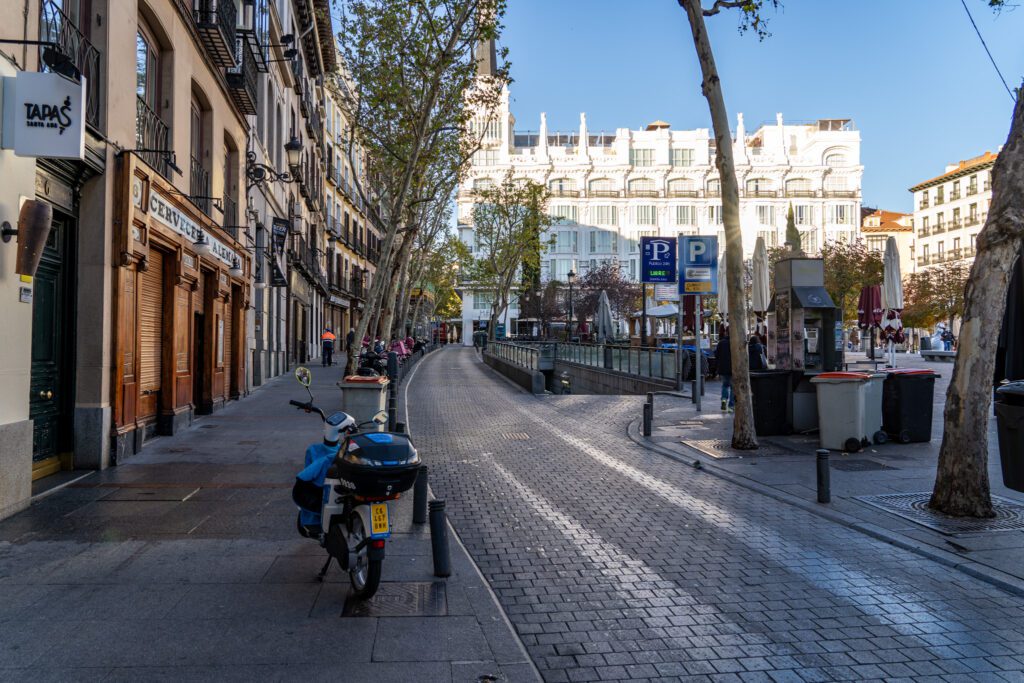
Barrio de las Letras is so-named because of its history of famous writers taking up residence in the neighborhood. It’s very central – tucked between Puerta del Sol and the Prado Museum – but it has a distinct feeling from the more commercial parts of town immediately adjacent to it.
Las Huertas is the main street, running west to east towards the Prado and Parque El Retiro, and the offshoots branching off of it are full of great restaurants and bars.
Plaza Santa Ana is the center of the neighborhood, serving as a welcome open space in a neighborhood of dense housing, bars, and restaurants.
The streets of Barrio de las Letras are adorned with gold letters spelling out famous passages and quotes from the many writers who called this area home.
As you walk its streets, you’ll find statues of Cervantes and Federico García Lorca (a famous poet), among others.
This neighborhood is also full of (or adjacent to? We aren’t quite sure where, exactly the border of the neighborhood falls) cultural marvels, from the Prado Museum and the Reina Sofía – two of the best museums in Madrid – to the CaixaForum Madrid, which we were immediately drawn to as we strolled by on a cold November morning thanks to its cool garden wall that climbs several stories with dense greenery, even in the late fall.
Pros and Cons of Staying in Barrio de las Letras
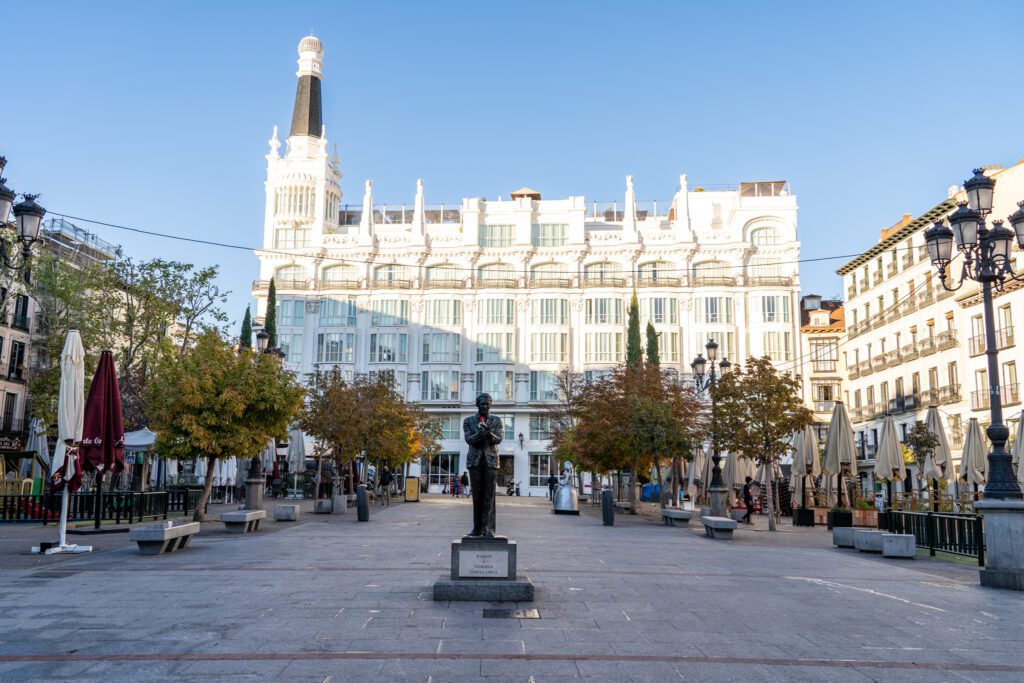
Pros of staying in Barrio de Las Letras
It’s full of bars and restaurants. Along with the other neighborhoods on this list, this area is a great place to explore for foodies. We think the moral of the story is that Madrileños love food, which we’re on board with.
It’s a hub of culture. From renowned art museums to music venues and statues of famous Spanish literary heroes, this neighborhood is the place to be for art lovers. You’ll be near the best art in Madrid, all the way from famous 15th Century paintings to modern day musical performances, and just about everything in between.
It’s super central. Walkable to the art museums and El Retiro park, and a hop, skip, and a jump away from the Sol metro station (near Puerta del Sol), you’ll be well connected to the rest of the city.
We don’t have a whole lot to say on the cons front.
If we were nitpicking, we’d say that there’s not a whole lot of options in terms of places to stay and that they’re a bit more expensive than in other parts of the city, but that’s a little harsh, we think.
The Best Places to Stay in Barrio de las Letras
Here are four places that caught our eyes as we were browsing the options of places to stay in the neighborhood.
Room Mate Alba: A Nice Boutique Hotel
Room Mate is a fairly well known hotel brand that we’ve found all over Spain and the rest of Europe. Not as well known as, say, Hilton or Marriott, but they have a presence on multiple continents.
They have a mix of hotels and apartments around the world, and this particular property – Room Mate Alba – falls squarely into the hotel category. And it’s a nice one, at that.
Rooms are relatively spacious, starting with the standard rooms at more than 200 square feet and increasing in size from there. Rooms are beautifully decorated, particularly the bathrooms with their intricate tilework that caught our eye.
There’s also an onsite gym and a daily breakfast buffet that runs until noon (at an extra cost, of course).
The hotel’s location couldn’t be better. It’s on Calle de las Huertas, about four blocks west of the Prado Museum, and within a couple of blocks of all the food and drinks in the neighborhood, and also the metro station at Antón Martín.
One Shot Prado 23: A Stylish & Affordable Hotel
One Shot Prado 23 is a relatively affordable option in a great location at the northeastern corner of Barrio de las Letras.
It’s right on Calle del Prado, which means you’re just a few blocks from the famous museum, along with other gems in the neighborhood like the statue of Miguel de Cervantes at nearby Plaza de las Cortes.
They’re also within 5-10 minutes of three different metro stations, so you’ll be able to jump around the city as needed.
The economy rooms – which can be outfitted with two twins or one double bed – are a fantastic value if you’re not too concerned about space and you’ll be spending most of your time outside of the hotel room.
If, like us, you’ll be spending some time in the hotel getting some work done, upgrade to one of the bigger rooms (standard and above), which have more space and, importantly, a desk.
Some rooms have balconies overlooking Calle del Prado, which are both a bit bigger and a bit more expensive.
They have an underground parking garage if you happen to be driving, which isn’t something that every place in Madrid has.
Apartamentos Matute 11: Classy Apartments
Look, sometimes living out of a hotel for more than a day or two can get tiresome.
We like to cook, and staying in an apartment allows us to do that and experience a slice of local life as we go to the grocery store or market, try to speak the language (in this case in Madrid, that just means hearing a lot of “vale vale” which roughly translates to…just about anything), and cooking up a simple meal.
In Barrio de las Letras, we’d go with these classy apartments that are located at the southern end of the neighborhood, within a couple of blocks of a metro station.
They have a mix of apartment types – studio, one bedroom, and two bedroom – all with varied layouts, some of which are definitely better than others (though there’s no way to tell which one you’ll get).
Decor is simple but stylish, with hardwood floors or tile (carpet is kind of gross sometimes) and fairly minimal decorations on the walls.
The apartments have a stovetop, but no oven (although the microwaves do double as convection ovens, which we’ve seen before but haven’t quite figured out just yet).
If you’re looking for an apartment where you’ll have more space and access to a kitchen AND you want to be well connected to the city – both on foot and by the metro – these apartments would be a great option.
Barrio La Latina: Local Vibes + Great Food and Drinks
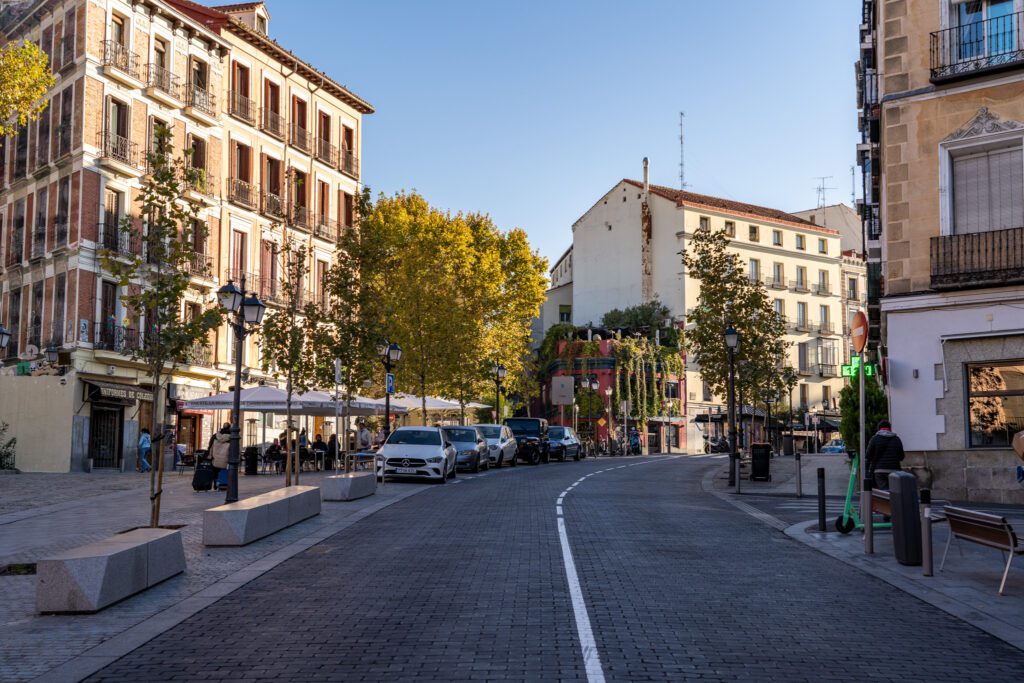
If we had to pick a second-favorite neighborhood after Malasaña, it would be La Latina. The second we crossed over its boundaries from Plaza Mayor, our eyes lit up.
Generally, there’s a strong correlation between a neighborhood that has plazas with local kids running around and the amount we like the area.
La Latina is a neighborhood that is named after Beatriz Galindo, a beloved teacher of Queen Isabella of Castile (and various other famous royals).
She was named “La Latina” because her grasp of Latin was prolific, and the neighborhood here bears her name because of her contributions to the neighborhood and city, where she founded a hospital and was one of the most prominent women in public life at the time.
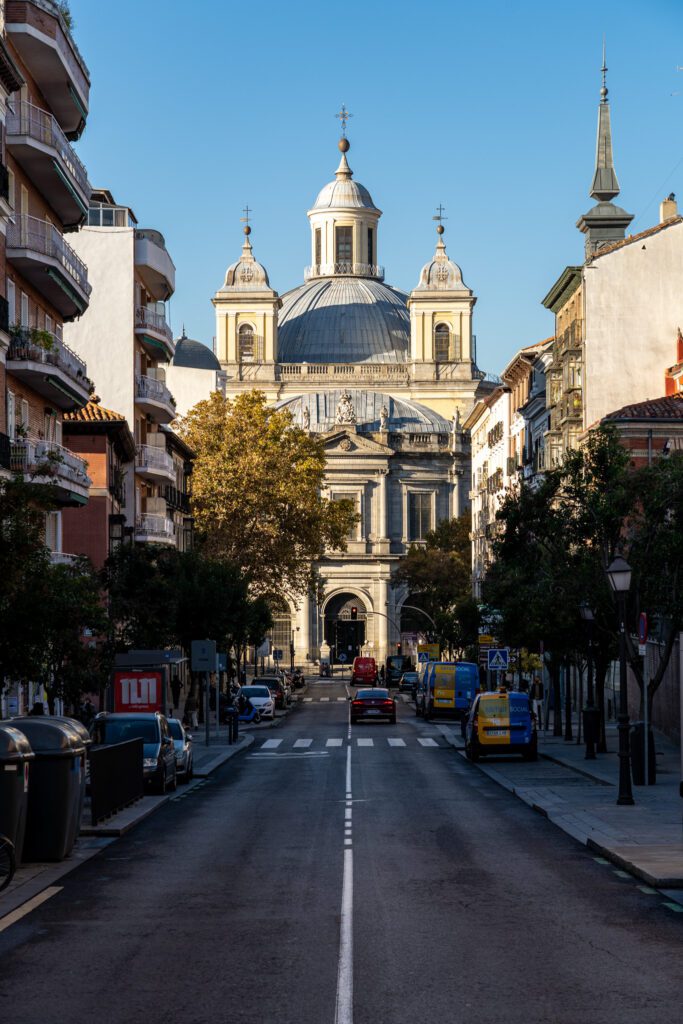
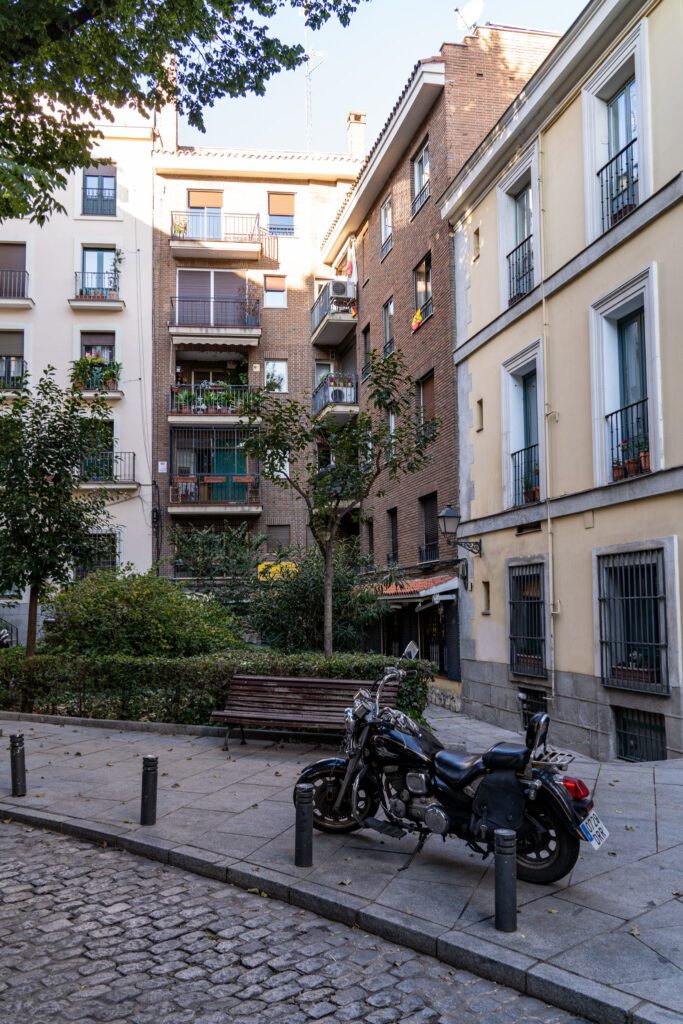
There are a couple of things we really enjoyed about La Latina.
First, if you want tapas, go to Calle Cava Baja, which is famously lined with tapas bars on either side of the street for several blocks (more on this in the “highlights” section below).
Second, the bustling plazas. We were here multiple times at various points in the day – early morning, noon, and late afternoon – and at all of those times, the open plazas were full of people either grabbing their morning coffee with friends, taking a break before going about their day, or eating tapas and drinking wine, beer, and vermouth in the warm sun.
Of course, it should definitely be noted here that this neighborhood, like most places in Madrid and around the world, has seen rising rents displace local families in service of short-term rentals meant for tourists.
Pros and Cons of Staying in La Latina
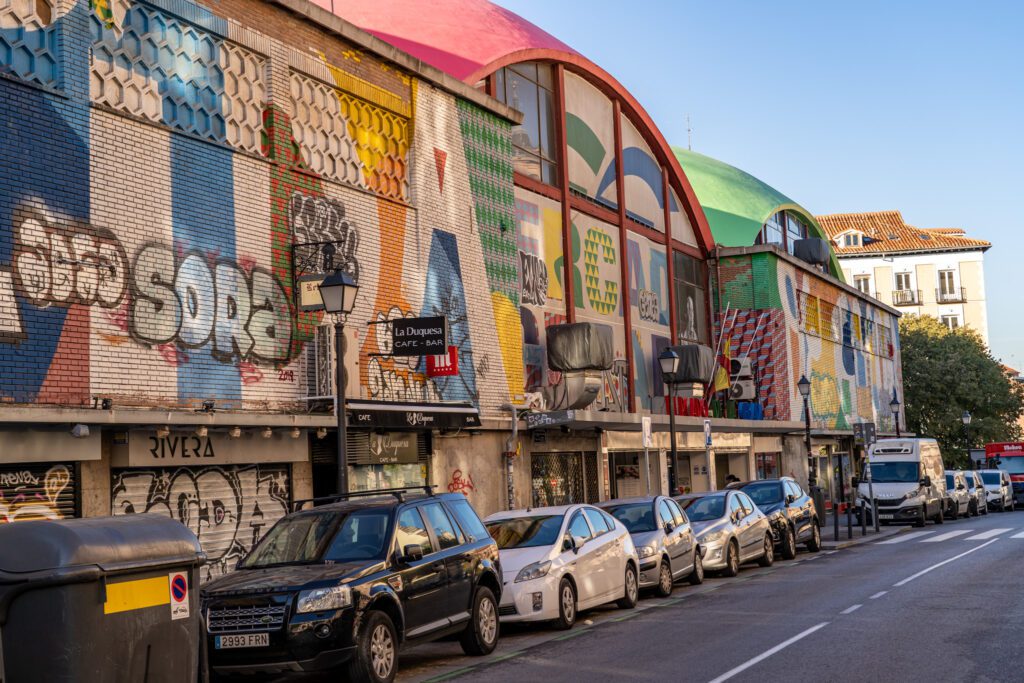
Pros of staying in La Latina
Charm Charm Charm. This area is endlessly charming, with tons of energy and people milling about at all hours. Tapas bars spilling into the streets. Open plazas with people sitting around catching up or taking a break after dropping their kids at school. The neighborhood takes up part of the oldest part of Madrid, and is full of narrow winding streets that feel like a maze.
It’s a central location. The other nice thing about La Latina is that it’s walkable to most of the city. You’ll be able to walk to El Prado and the Royal Palace, and if you don’t feel like walking, there’s a very convenient metro station right in the heart of the neighborhood.
Cons of staying in La Latina
There aren’t many places to stay. This area is a bit more residential than some of the others in this guide, so there aren’t as many places to stay. Since we do not recommend staying in an Airbnb in Madrid, which has helped contribute to a housing crisis where locals who have lived here for decades can no longer afford it, the choices are relatively slim. However, there are still some cool places to stay here, so don’t discard it altogether!
It can get loud and boisterous. This area is very popular, and as a result it can be loud and filled with a frenetic energy. Particularly on weekends and at night.
The Best Places to Stay in La Latina
Here are five places that caught our eyes as we were browsing the options of places to stay in the neighborhood.
We’ve done our best to include places for all budgets and styles – from fancy schmancy boutique hotels, to affordable hostels.
Plus, apartments with a kitchen, which is something we often find we need when we’re on the road (Matt has Celiac Disease and needs to eat gluten free – check out our guide to eating gluten free in Madrid!).
Posada del León de Oro: A Boutique Hotel in a Great Location
This boutique hotel is right at the northern end of Calle Cava Baja, which means you’re within about three minutes of being right in the heart of all the action.
Plus, you can easily walk to places north of La Latina, like Plaza Mayor. The location is honestly just about perfect.
It’s in a 19th Century building that has been lovingly restored, and the 17 rooms are modern and elegant, though not in a stuffy way at all.
It’s a relatively small hotel, which is a nice alternative to some of the bigger mega-hotels in Spain’s capital.
L&H La Latina Selection: A Nice Mid-Range Hotel
This mid-range hotel is towards the southern edge of the neighborhood, which means it’s going to be significantly more quiet and relaxed than the places up near Calle Cava Baja.
The rooms are nicely laid out, and more importantly, have a microwave, mini fridge, and stovetop in the room! Plus, a Nespresso machine for your morning coffee.
They have standard hotel rooms of various configurations and sizes, plus a couple of deluxe attic rooms with a private terrace, and suites with a little more space, including a living area.
The decor is stylish and simple, with big gray headboards and two pieces of artwork hanging above the bed, and big rainfall showers.
They also have parking, which is a plus if you’re going to be driving in Spain.
Casa du Soleil: A Small, Stylish B&B
Okay, TECHNICALLY this is just outside the eastern border of La Latina, but it’s within a few blocks of La Latina metro station, so we’re going to include it because we think it’d be a great place to stay.
Casa du Soleil is a new hotel, opened in 2021, and you can tell when you look at the style. It’s very boho-chic, if you know what we mean.
They ONLY have double rooms, which means it’s probably not a great option for families or groups traveling together.
They do have a communal kitchen for you to use, where you’ll find free coffee and plenty of common areas for relaxing (or getting some work done).
The Hat: An Upscale Eco-Hostel
We had this stylish eco hostel booked for our stay in Madrid at one point, but we weren’t sure whether the communal kitchen would be accessible when we were there, so we ended up switching to an apartment with a kitchen.
It’s also worth noting that the kitchen facilities here are fairly limited – a microwave and kettle, no stove – if that’s something you care about.
On our next trip, we’d have this place at the top of our list.
We’re all about the boutique hostel trend that is currently taking popular cities around the world by storm.
They combine the comfortable, stylish rooms you’d find at a boutique hotel with the social aspects you get from staying at a hostel, at a relatively affordable price (usually).
The Hat is one of the nicest hostels we’ve come across in our extensive search for the perfect place to stay in cities around the world. It’s on the northern edge of the neighborhood, pushing into the area around Puerta del Sol, which is a great central location for exploring Madrid.
They have a combination of dorm rooms (including female-only dorms) and private rooms that are essentially hotel rooms.
You’ll also have access to their extensive breakfast, the rooftop bar, and their various common spaces that all seem to be filled to the brim with natural light.
Barrio de los Austrias: The Historic Center of Madrid
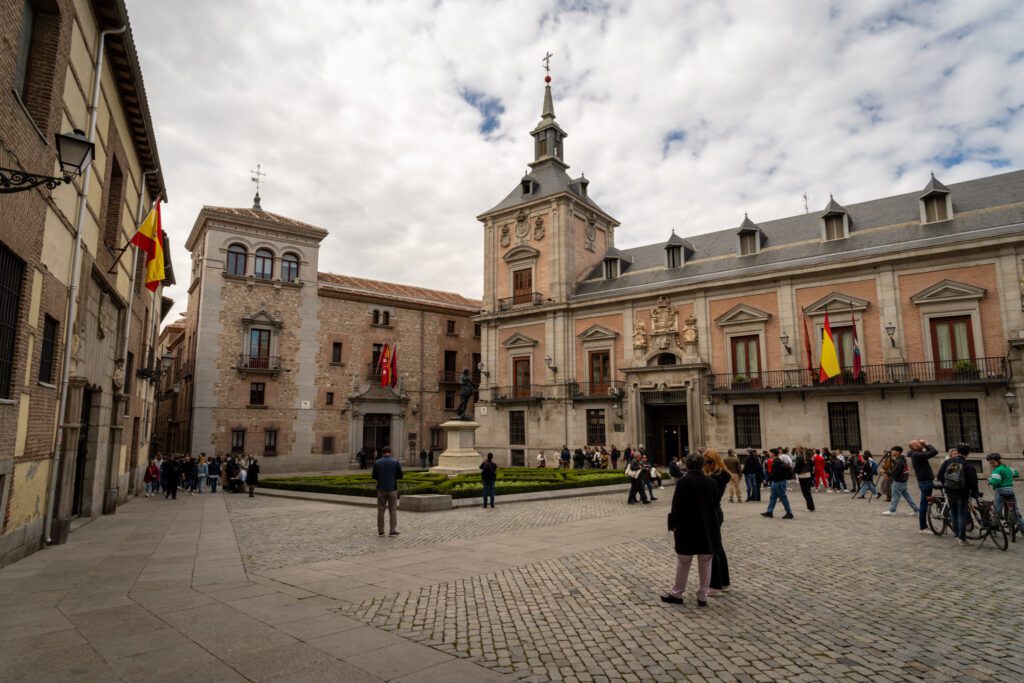
This neighborhood is the historic center of Madrid, which was largely built out in the 16th and 17th Centuries under the Hapsburgs, who ruled Spain for a few hundred years and hailed from Austria, hence the name.
Spain’s history is fascinating, and is something we never really learned about in history class in the USA (apart from the whole Christopher Columbus saga).
Between the 800 year war between Christians and the Islamic Caliphate on the Iberian Peninsula (known as the “Reconquista”) and the drama-filled fights for control of the Spanish empire post-Reconquista, it’s quite the story.
Funny enough, despite the fact that it’s the capital, Madrid’s history doesn’t really start until the 16th Century, when it became the capital more or less overnight, and started to rapidly expand.
Now, the neighborhood here is a little amorphous, and we’re combining a few different neighborhoods that overlap (Sol, Gran Vía, and Barrio de los Austrias) into one bigger neighborhood that covers the historic center of Madrid.
The middle of that original city is centered around the area between the Royal Palace and Plaza Mayor today, which were encircled by a city wall. The northern and southern borders are roughly Gran Vía and Calle de Segovia, respectively.
Generally speaking, we prefer the part of this neighborhood that is further south. As you get closer to Gran Vía and Puerta del Sol, it starts to get more commercial, with wide, pedestrian-only streets lined with chain stores like Foot Locker and Levi’s, and it feels a little bit like Times Square in New York City, or Union Square in San Francisco
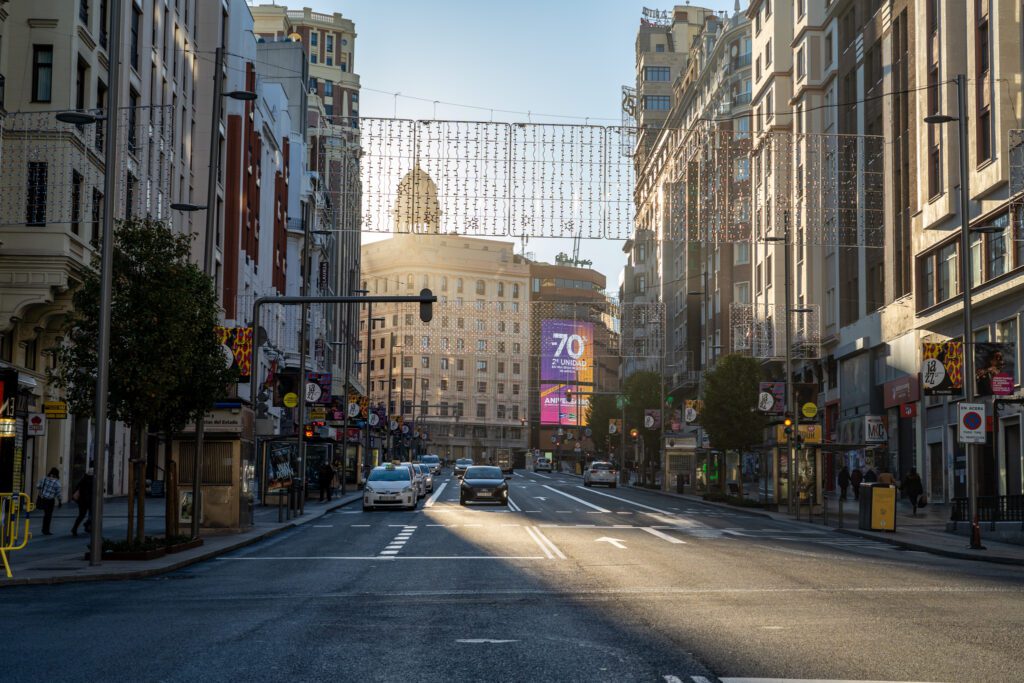
We stayed here, right on Gran Vía, which is about as central as it gets. We were within walking distance (15 minutes or less) to everywhere we wanted to go in Madrid, and as a result we ended up using the metro a lot less than we had initially planned.
However, being right on that main, modern boulevard kind of sucks (in our opinion, anyway), and we’d recommend that you stay further south (or another neighborhood entirely).
It’s also well-connected to the train station (Atocha train station, which is where you’re likely to arrive if you’re traveling to Madrid by train) and airport thanks to the “Sol” regional train stop.
It’s one stop and 2.20 Euros to the train station (the transfer to or from the regional trains is usually included with long distance train tickets), and it’s an easy journey to the airport.
Pros and Cons of Staying in Barrio de los Austrias
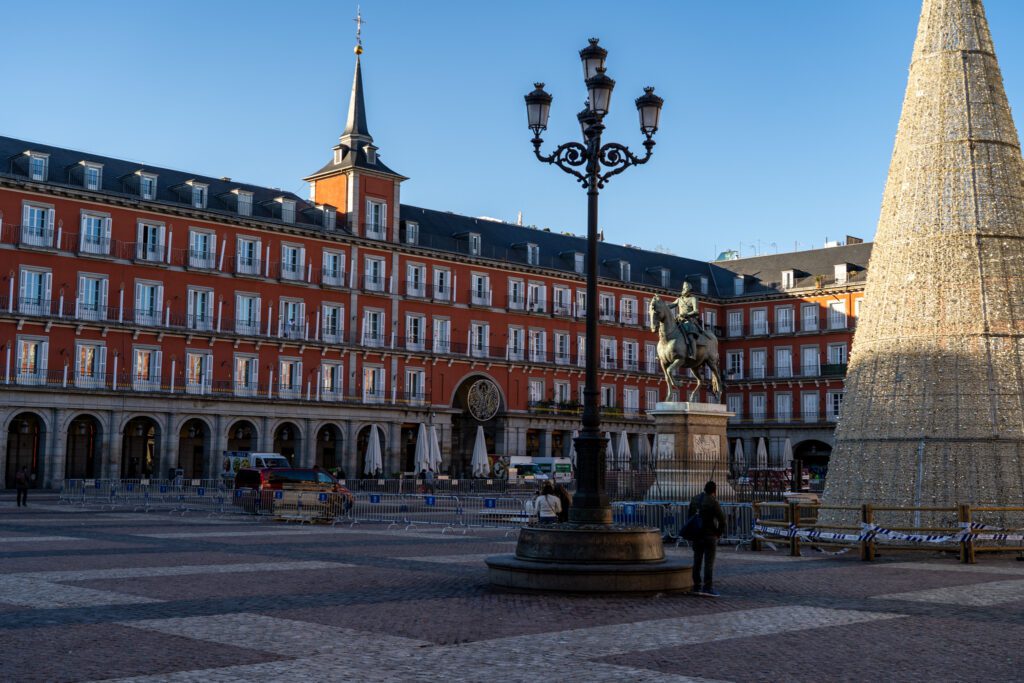
Pros of Staying in Barrio de los Austrias
It’s as central as it gets. Puerta del Sol and Plaza Mayor are in the neighborhood, and just outside of it you’ll find La Latina (great tapas and full of charm) and Malasaña.
It has good shopping. If you’re looking to do some shopping, this is probably the place to do it. There’s an incredible variety of shops selling everything from clothes to electronics, and just about anything else you can think of. If you need a new pair of jeans or a pair of Spanish-crafted Espadrilles, head here.
There are plenty of hotel options. There are a lot of places to stay in this corridor, as you might imagine. From hotels to apartments, you’ll have your choice of style and budget.
Cons of Staying in Barrio de los Austrias
It feels relatively lifeless. As you cross Gran Vía coming from Malasaña, you’ll trade the charming locally-owned boutiques for chain stores that exist all over the world.
Instead of a wide variety of small restaurants, you get Five Guys and Burger King.
This is a generalization, of course, but it’s just not that charming. You’ll end up spending most of your time outside of the neighborhood, which isn’t a bad thing especially considering you’ll be able to walk anywhere you want to go.
I will say that the southern end of the neighborhood – around Plaza Mayor and to the south – is a little more fun and charming.
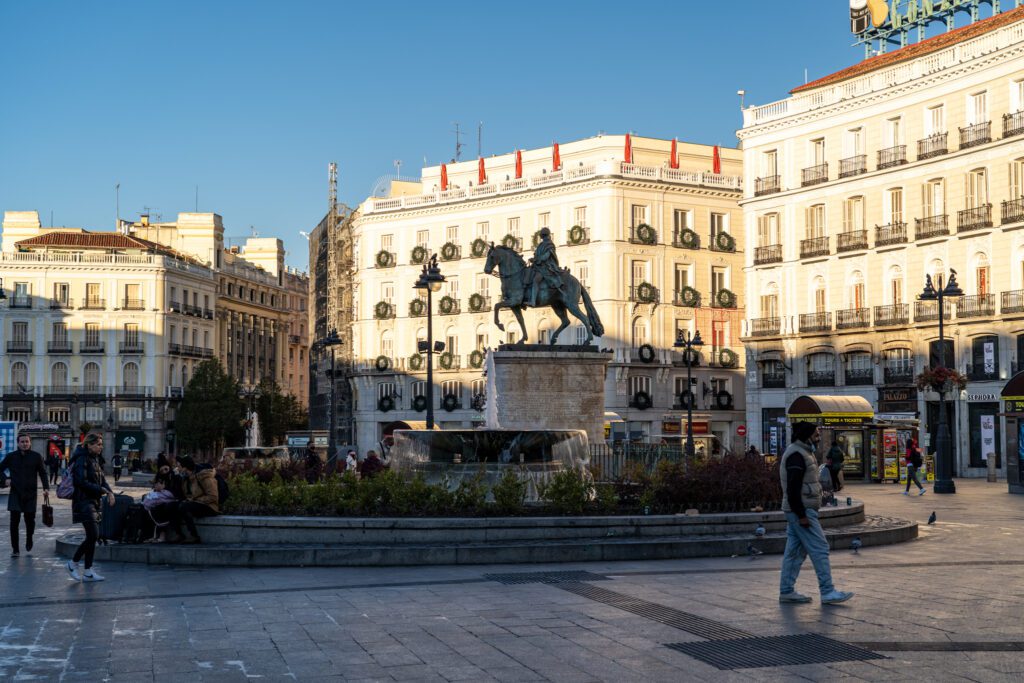
Planning a trip to Spain? We’d love to help!
Here are our other Spain travel guides to help you plan an incredible trip (even if you have to eat gluten free!).
If there’s no link below, it means we’re still working on it – long, in-depth guides take time! We’re working on it, though, we promise.
The first place to start, if you haven’t already found them, is with our detailed itineraries. We have one shorter version for 7 days in Spain, one version that covers 10 days in Spain (a good middle ground, we think), and one longer version for two weeks in Spain (with ideas for more and less time in both guides).
Our Barcelona Guides
- What to do in Barcelona (as a First Timer)
- How to Plan an Amazing 4 Day Barcelona Itinerary
- Where to Stay in Barcelona: A Complete Guide for First Timers
- 12 Things to Know Before You Visit Barcelona
- Gluten Free Barcelona: A Complete Guide to GF Restaurants + Bakeries
- Where to Find the Best Specialty Coffee in Barcelona
- How to Plan an Incredible Day Trip to Montserrat (from Barcelona)
Our Madrid Guides
- What to do in Madrid (as a First Timer)
- How to Plan an Amazing Madrid Itinerary (2 Days)
- Where to Stay in Madrid: A Complete Guide for First Timers
- 12 Things to Know Before You Visit Madrid
- Gluten Free Madrid: A Complete Guide to GF Restaurants + Bakeries
- Where to Find the Best Specialty Coffee in Madrid (for Coffee Nerds)
- How to Plan an Amazing Day Trip to Toledo (from Madrid)
The Rest of Spain

Hello, thank you for your very comprehensive guide to Milan! I noticed that you mentioned about air bnb prices driving locals out, I wondered why you write specifically not to air bnb in the Latin Quarter? Is this for the same reason? Many thanks! Emma
Hey Emma! While Airbnb being a problem for housing for locals is more or less true about every neighborhood in central Madrid (and every other major city in Europe and North America, really), it’s more pronounced in La Latina, which hasn’t really been zoned or designed to be a neighborhood for tourists. Unfortunately, the rise of short term apartment rentals has caused rents in La Latina to rise at a rate that is unsustainable for the people who actually live there.